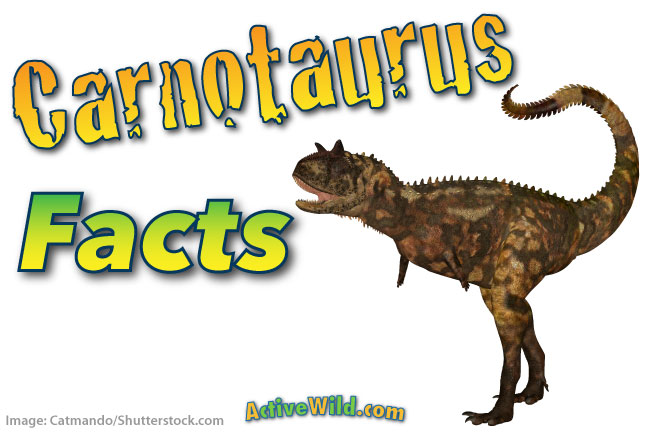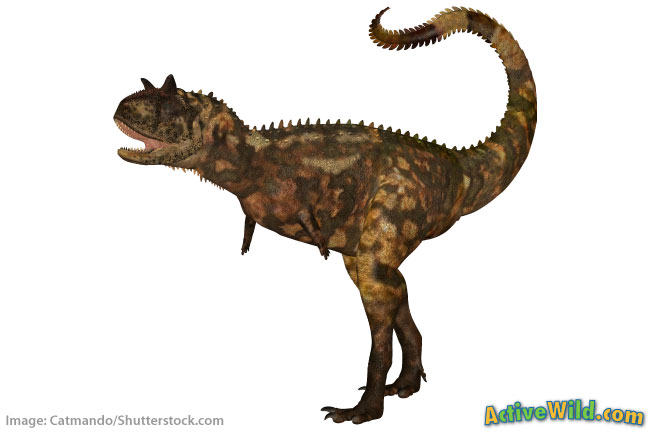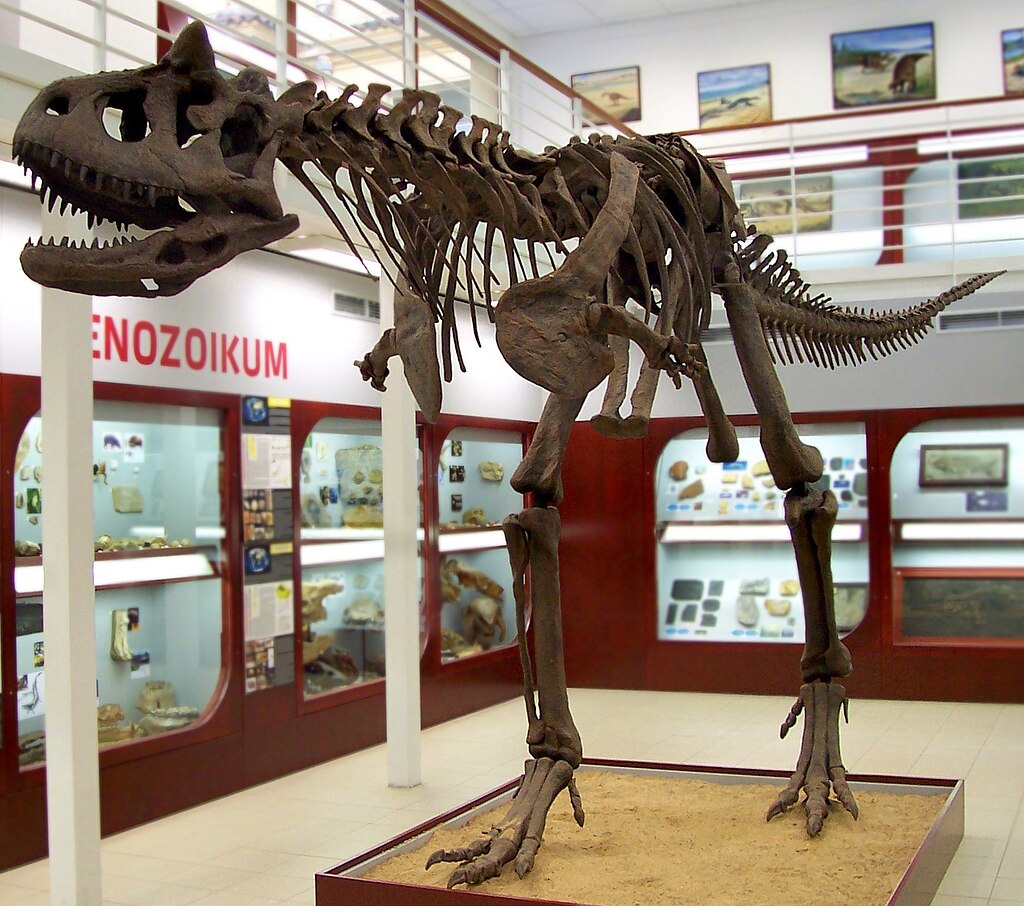Carnotaurus facts, information and pictures for kids, students and adults. On this page, we’re going to meet Carnotaurus, a large South American meat-eating dinosaur ... with horns.
- This article is part of our Dinosaur Facts series.
Carnotaurus Facts, Information And Pictures For Kids, Students And Adults
Carnotaurus was a mid-sized theropod dinosaur. It lived in what is now South America in the late Cretaceous period, around 72 to 69.9 million years ago.
What Did Carnotaurus Look Like?
The artist's impression below is one interpretation of what Carnotaurus looked like.
Carnotaurus had the typical ‘look’ of a theropod such as T Rex. It was bipedal (i.e. it walked on two legs), and had a long tail that provided balance and stability. Like T-Rex it had short arms and a big head.
However, there are one or two things about Carnotaurus which differentiate it from other, similar dinosaurs.
Horned Dinosaur
Carnotaurus was one of the few theropod dinosaurs to have horns. Positioned just above the eyes, the horns were thick at the base and cone-shaped. Although the fossilized horns are relatively short and blunt, in a living dinosaur these bony stubs may have had a longer and more pointed non-bone outer layer.
There are a number of theories as to what Carnotaurus's horns were for:
Some paleontologists think Carnotaurus males used their horns to fight among themselves to establish dominance – in much the same way as deer stags do today.
Other paleontologists think that the horns were used to attack prey animals.
Carnotaurus had a powerful neck, suggesting that its head could have been used like a battering ram – either for hunting or for fighting another Carnotaurus.
Other studies have shown that Carnotaurus’s top jaw may have been used to batter large prey animals – likely to have been sauropods – into submission.
Carnotaurus had a proportionally shorter skull than similarly-sized dinosaurs. Its jaws are curved, giving it a rather frightening grin.
How Big Was Carnotaurus?
Carnotaurus was between 8 and 9 metres (26 and 30 ft.) in length. Although it was relatively big, it was lightly-built. It weighed around 1.35 metric tonnes (3,000 lbs.).
Short Arms
Carnotaurus had shorter arms than any other large meat-eating dinosaurs. Yes, its arms were even shorter than the famously short-armed T Rex!
Scientists believe that the arms of Carnotaurus may have been ‘vestigial’. This is when a body part has lost its functionality but has remained present on an animal as it evolved.
Perhaps Carnotaurus’s arms served no purpose at all!
Fastest Large Theropod
Compared to other large, bipedal meat-eating dinosaurs, Carnotaurus was reasonably large, but quite lightly-built. It seemed to have been designed for speed rather than strength.
It had long, powerful legs, which scientists think may have allowed it to reach speeds of up to 35 mph (56 km/h).
Carnotaurus could quite possibly have been the fastest large theropod.
Skin
All that we know about Carnotaurus comes from just one skeleton. However, it is one of the best-known theropods from the southern hemisphere because the skeleton was so well-preserved.
The specimen was in such good condition that skin impressions were present. These revealed that much of Carnotaurus’s skin was made up of small (5mm in diameter) scales.
Larger bumps were also found. These may have been 'scutes' – bony plates that formed in the skin, like those running down the back of Ankylosaurus.
Carnotaurus Facts: Name
The name Carnotaurus comes from the Latin words for ‘meat’ and ‘bull’. Therefore, Carnotaurus means ‘meat-eating bull’. The name refers to Carnotaurus’s dietary preferences and its bull-like horns!
Carnotaurus is a genus (a 'type' of animal). The name given to the only known species of Carnotaurus is Carnotaurus sastrei. The ‘sastrei’ part comes from the name of the owner of the farm on which Carnotaurus was discovered, Angel Sastre.
Where Did Carnotaurus Live?
Carnotaurus was found in Chubut Province, Argentina in 1984, during an expedition led by Argentine paleontologist José Bonaparte.
In the late Cretaceous, when Carnotaurus walked the earth, South America was separated from both Africa and North America.
Carnotaurus Fossils
If you're interested in seeing Carnotaurus in the flesh (okay, not in the flesh, but you know what we mean), you can visit the Argentine Museum of Natural Sciences.
Residents of California can see a life-sized replica of the skeleton at the Natural History Museum of Los Angeles County.
Several other Carnosaurus reconstructions are on display, including the one below, which can be seen in Prague.
Carnotaurus Family & Relatives
Carnotaurus is a member of the Abelisauridae family of dinosaurs. Carnotaurus was the second member of this family to have been discovered; Abelisaurus, from which the group gets its name, was the first.
Top Ten Carnotaurus Facts
- Carnotaurus was a theropod dinosaur of the late Cretaceous period.
- It lived around 72 to 69.9 million years ago
- Carnotaurus was a member of the Abelisauridae family of dinosaurs.
- Carnotaurus has distinctive horns above its eyes.
- Carnotaurus’s arms are even shorter than those of T Rex!
- Carnotaurus was light, and built for speed. It could probably reach speeds of around 35 mph (56 km/h).
- All that we know about Carnotaurus comes from one skeleton, which was discovered in 1984 by paleontologist José Bonaparte.
- The skeleton was so well-preserved even the dinosaur’s scale patterns were visible.
- Carnotaurus means ‘meat-eating bull’
- Carnotaurus was found on a farm in Argentina. The species, Carnotaurus sastrei, was named after Angel Sastre, the owner of the farm.
Carnotaurus Facts: Conclusion
We hope that you have enjoyed learning about this speedy but fierce predator. You can find out about its close relative the Abelisaurus here.
There is plenty more free dinosaur information on Active Wild. Become a dinosaur expert today!
- A complete guide to dinosaurs can be found here: Dinosaur Facts and Information.
- Learn about other types of dinosaur here: Dinosaur List with Pictures and Information.





